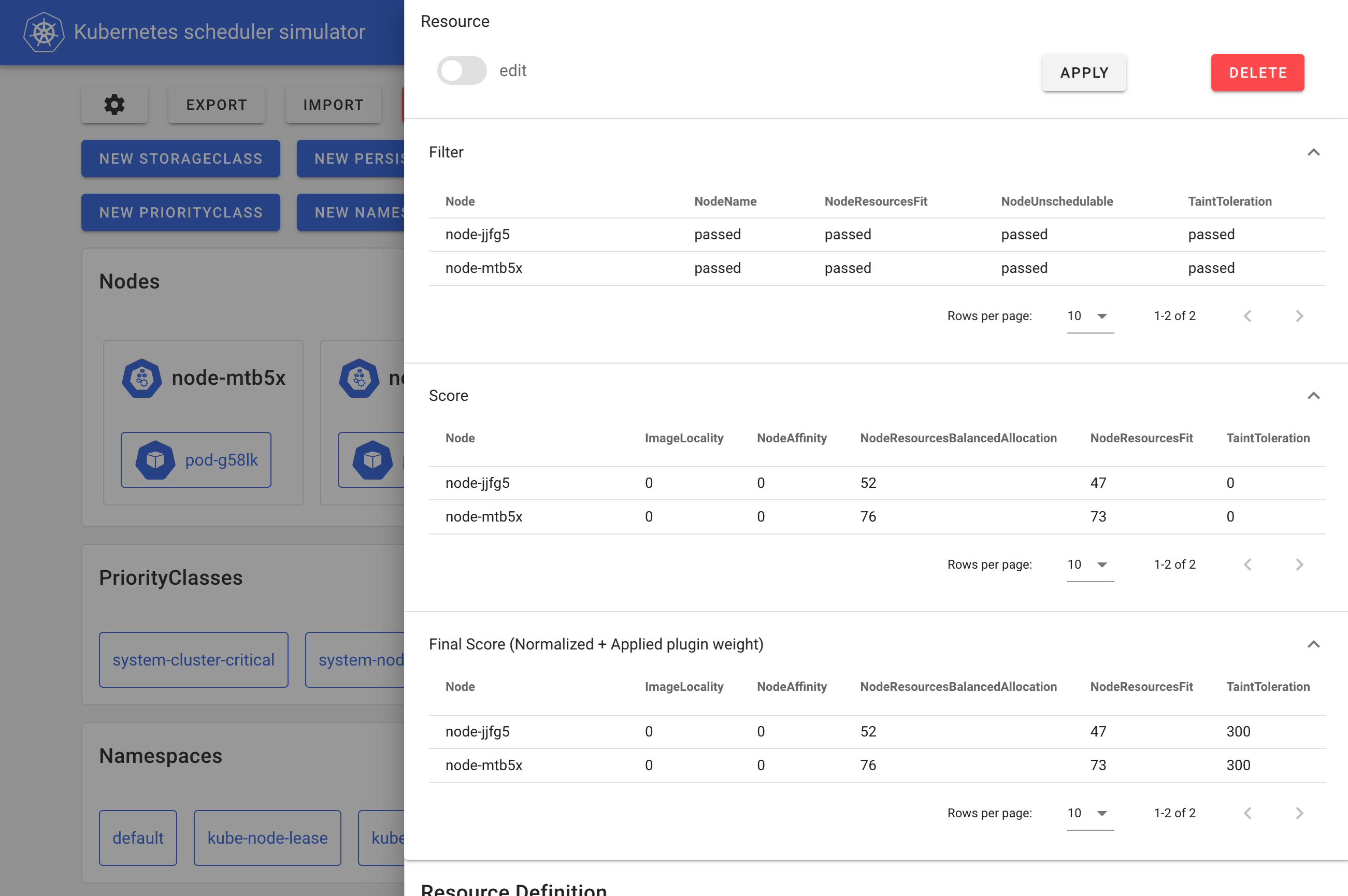Kube-Scheduler-Simulator: Advanced Debugging Insights

The Kubernetes Scheduler is one of the critical control plane components in any Kubernetes cluster. It is responsible for assigning Pods to nodes based on a plethora of factors ranging from resource availability to affinity rules. In essence, every Kubernetes-based system depends on this scheduler to ensure workloads are distributed efficiently across the cluster.
kube-scheduler-simulator is a simulator derived from a project that began during Google Summer of Code 2021 and has since evolved with significant contributions from the community, including its creator, Kensei Nakada. This tool provides an unprecedented glimpse into the scheduler’s decision-making process, allowing users to trace, debug, and analyze every step of how scheduling decisions are made in a Kubernetes environment.
From casual Kubernetes users who implement scheduling constraints (such as inter-Pod affinity) to advanced users extending the scheduler with custom plugins, kube-scheduler-simulator caters to a wide audience by offering a detailed breakdown of scheduling internals.
Motivation
The Kubernetes scheduler has long been perceived as a black box. It is composed of many plugins that each contribute individually to the scheduling decision. This layered approach leads to a complex interplay of factors, making the internal workings difficult to trace in real production scenarios.
For instance, a Pod that seems to be scheduled correctly in a simple test environment might be placed on a node for reasons that differ almost invisibly from what is expected. This hidden complexity can result in unexpected scheduling decisions in production, where resource dynamics and workload scales differ drastically from a development cluster.
Moreover, testing a scheduler is inherently challenging. The nearly infinite possible interactions within a live cluster environment mean that no development setup can fully predict every behavior. In many cases, bugs remain hidden until the scheduler is deployed in real-world clusters—a scenario that has led to bug discoveries even in upstream Kubernetes releases.
Traditional development clusters often fail to capture the full workload patterns of production environments. The simulator bridges this gap by enabling the simulation of production-like conditions, thus allowing users to export cluster resources, test new scheduler versions, and debug complex scheduling decisions without affecting live workloads.
Features of the kube-scheduler-simulator
The core appeal of kube-scheduler-simulator lies in its ability to make the scheduler’s internal decisions transparent. Utilizing the Kubernetes scheduling framework, the simulator covers multiple extension points throughout the scheduling process. It shows how plugins are called during phases such as filtering and scoring, and ultimately, how the best node is selected for a Pod.
Users can create Kubernetes resources within the simulator and observe real-time feedback on how each plugin influences the scheduling process. This not only helps in troubleshooting but also in fine-tuning scheduling constraints to meet specific architectural or operational needs.

The simulator web frontend
Inside the simulator, a debuggable version of the Kubernetes scheduler replaces the default scheduler. This variant not only performs standard scheduling but also annotates the Pods with detailed debug output from each extension point. The annotations, as illustrated in the example below, include the outcomes of various plugin calls (bind, filter, score, etc.).
kind: Pod
apiVersion: v1
metadata:
# Detailed scheduling results are stored as annotations
annotations:
kube-scheduler-simulator.sigs.k8s.io/bind-result: '{"DefaultBinder":"success"}'
kube-scheduler-simulator.sigs.k8s.io/filter-result: >-
{ "node-example": { "NodeName":"passed", "NodeResourcesFit":"passed", "TaintToleration":"passed" } }
kube-scheduler-simulator.sigs.k8s.io/finalscore-result: >-
{ "node-example": { "NodeResourcesBalancedAllocation":"50", "NodeResourcesFit":"45", "TaintToleration":"300" } }
kube-scheduler-simulator.sigs.k8s.io/selected-node: node-example
This framework is designed with extensibility in mind. Developers can integrate their own custom plugins or even legacy extenders, and then incorporate the results directly into the debugging output, rendering complex decisions much more accessible.
The Simulator as a Superior Dev Cluster
Standard development clusters are inherently limited by their size and simplified workload dynamics which seldom represent the true behavior of production clusters. The simulator’s importing feature mitigates this discrepancy by allowing administrators to clone production-like conditions.
By continuously syncing resources from a live production cluster, users can test new scheduler releases and configurations in an environment that mirrors the complexities of a production scenario. This advanced preparation helps in identifying unforeseen issues before a full production rollout, thereby reducing risk and enhancing the reliability of deployments.
Technical Analysis and Best Practices
The kube-scheduler-simulator leverages several advanced concepts from the Kubernetes scheduling framework:
- Filter and Score Phases: The simulator details how nodes are first filtered using plugins that verify constraints (e.g., resource availability, taints) and then scored based on criteria like balanced resource allocation and affinity policies.
- Debug Annotations: Each phase generates a set of debug annotations on the Pod. This granular logging, split across phases like
prefilter,postfilter, andprescore, provides developers with a complete breakdown and transparency of scheduling decisions. - Real-time Integration: The debuggable scheduler can run standalone, making it ideal for automated integration tests, live-debug sessions, or continuous integration systems. This allows custom plugins to be analyzed in real-world scenarios within a controlled testing environment.
Experts recommend using kube-scheduler-simulator as part of a comprehensive testing suite to eliminate potential problems early in the development process. It also plays a crucial role in operational rotations and in scenarios where rapid bug resolution is essential.
Seamless Integration with Custom Plugins and Extenders
For organizations that have extended the default Kubernetes scheduler with custom functionalities, kube-scheduler-simulator offers a valuable sandbox. Developers can integrate their proprietary scheduling logic into the debuggable scheduler, monitor the resulting annotations, and fine-tune behavior before actual deployment.
This approach streamlines the development of sophisticated scheduling plugins by integrating them into an environment that mimics production conditions using real resource constraints. It further enables the continuous integration of new scheduler configurations with rigorous regression tests, ensuring that extended functionalities do not introduce new vulnerabilities or performance bottlenecks.
Future Developments and Expert Opinions
Industry experts foresee the role of simulation environments like kube-scheduler-simulator growing in the near future. As Kubernetes clusters become more sophisticated with emerging trends like serverless computing and multi-cloud integrations, the need for advanced debuggability and simulation becomes paramount.
Leading voices in the DevOps community argue that real-time simulation and testing of scheduler enhancements not only accelerates innovation but also significantly reduces the risk of deployment failures. Discussions on community channels such as the #sig-scheduling Slack channel underscore the simulator’s importance as an educational tool and an integral part of the modern Kubernetes development lifecycle.
Moreover, the feedback loop established by continuously syncing production clusters with the simulator aligns well with modern CI/CD best practices and helps maintain operational excellence across cloud environments.
Getting Started
The simulator is straightforward to set up and only requires Docker to run—making a full Kubernetes cluster unnecessary for initial experiments.
git clone git@github.com:kubernetes-sigs/kube-scheduler-simulator.git
cd kube-scheduler-simulator
make docker_up
After launching the simulator, access the web UI at http://localhost:3000 to start exploring detailed scheduling results. For further guidance, the kube-scheduler-simulator repository contains comprehensive documentation.
Getting Involved
The kube-scheduler-simulator project is maintained by the passionate team at Kubernetes SIG Scheduling. Developers, cluster admins, and enthusiasts are encouraged to contribute through feedback, submitting pull requests, or engaging in issue discussions.
To stay updated and participate in ongoing conversations, please join the discussions on the #sig-scheduling Slack channel or contribute directly via the project repository.
Acknowledgments
The development and evolution of kube-scheduler-simulator have been driven by dedicated volunteer engineers and community contributors. Their collective effort has paved the way for improving Kubernetes cluster reliability and transparency.
A special thank you to all the contributors who have made this tool a mainstay for debugging and innovation in Kubernetes scheduling.
Conclusion
In conclusion, kube-scheduler-simulator represents a significant advancement in our ability to understand and optimize Kubernetes scheduling. Whether you are a cluster user, an administrator, or a plugin developer, this tool provides invaluable insights into the performance and decision-making logic of one of Kubernetes’ most critical components.
As Kubernetes continues to evolve, tools such as this will remain essential in bridging the gap between development and production, ensuring that our clusters are both efficient and resilient.